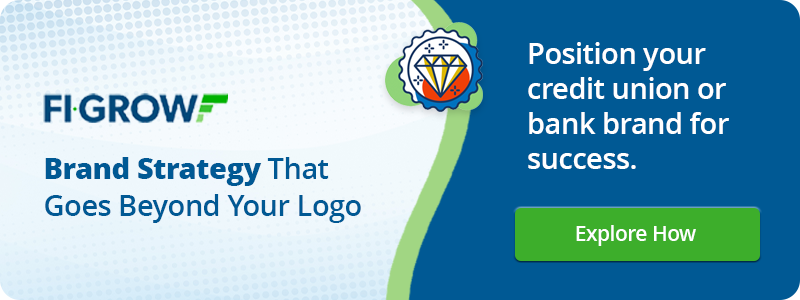Episode 84-Unconventional Ways for a Bank or Credit Union to See Success on Social Media


Don't Miss An Episode, Subscribe Now

Join Meredith Olmstead, CEO of FI GROW Solutions, and Sophie Bawany, our in-house social media expert, as they discuss innovative social media strategies for financial institutions. They explore key tactics to improve brand sentiment, engagement, and internal collaboration to build stronger customer relationships and achieve impactful digital results.
Key Takeaways:
-
Enhanced Brand Sentiment through Genuine Interactions: Sophie emphasizes how authentic social media interactions can significantly boost how members perceive a brand, leading to increased engagement and responsiveness.
-
Deeper Engagement Beyond Conversions: The conversation highlights that social media’s role extends beyond immediate financial transactions; it’s crucial for cultivating long-term relationships with both potential and existing customers.
-
Leveraging Feedback for Continuous Improvement: They underline the importance of using social media feedback to refine services and products, enhancing customer satisfaction and making social media efforts more effective and measurable.
Transcription:
Meredith Olmstead:
Hi there. I'm Meredith Olmsted, CEO and founder of FI GROW Solutions. We are a digital marketing and sales consulting agency and we work exclusively with banks and credit unions. And I am here with one of our inbound marketing strategists and our social media guru, Sophie Bawany. Say, hi, Sophie.
Sophie Bawany:
Hi.
Meredith Olmstead:
So Sophie and I have been talking recently about ways that we need to continue to measure the success of social media campaigns for our client credit unions or banks. And I know social media has been around for a while, but I really thought it was worth it to pause and hit record on this conversation because honestly, social media is so difficult to really get your head around and understand where the positive impacts are for a financial institution. And that's what Sophie does with our clients pretty much every day. And so what I wanted to talk with her and kind of pick her brain about was what are some additional ways that we are looking to measure success of social media campaigns for clients, and when I say additional, I mean, usually everybody knows you want new accounts, you want people to start applications, you want loan applications, you want new accounts open, you want to drive new deposits or all of these things, right?
So that's a really easy way to measure the success of a social media campaign is like, let's see how many new contacts came in, how many started applications, how many finished applications, how many led to new loans or accounts? So that's a really easy way to put kind of some numbers around the success of social media. But social media isn't just about the actual end conversion because a lot of times social media is about nurturing and building a relationship with a potential new customer or member or an existing customer or member and deepening that relationship with them. And that's much harder to quantify and measure. So Sophie, let's get started on this. So first thing we started, we were talking about this is we were talking about brand sentiment and engagement. So talk to me about what do we mean by brand sentiment and how social media campaigns can positively impact brand sentiment?
Sophie Bawany:
So it's really interesting when we talk about traditional ways of reaching people, social media and the users are very savvy at knowing what's authentic and what's inauthentic. So when you actually build a real relationship and have genuine interactions, the perception of the member or the user, it gets better. And as that perception gets better, automatically and organically your relationship is going to deepen. So you're going to get better results. They're going to be more proactive in talking about you. So you can do something as easy as throw out a survey, and if you have good relationships with your existing member base on social media, they're immediately going to respond to that survey and you'll get genuine real feedback.
Meredith Olmstead:
Okay. And so then if we're measuring over time, so say from 2023 to 2024, if we wanted to kind of have an idea of if our efforts not just on social media, but everywhere were positively impacting brand sentiment, what would be a metric that a credit union or a bank could take a look at?
Sophie Bawany:
Just the quality of the surveys. For example, if I put out a survey on a story for social media in 2023 and I only got 20 results, and then I really focused in 2024 on nurturing and building my social media presence, and I put a similar survey out in 2024 and I got 150 results, that's showing me growth. That's showing me more engagement. That's showing people want to answer and engage with us.
Meredith Olmstead:
Yeah, the other thing too would be just like an NPS survey, which is a basic survey that a lot of institutions do on an annual basis of existing customers. And so they could potentially look year over year at NPS numbers. Now obviously social media efforts aren't going to be the only influence of those efforts, but it can lead to understanding whether or not you're positively impacting brand sentiment. Obviously brand sentiment gets influenced by lots of things, but social media campaigns and interactions and engagement can definitely be part of that. So then what about if you're trying to, so in terms of engagement and meaningful interactions, tell me a little bit about why that is a really important way to measure the success of social media for a bank or credit union.
Sophie Bawany:
It's really interesting because even though our knee-jerk reaction is to sell, as a bank or credit union, you want to talk about your product, talk about how you can save money, the user journey experience on social media is very different. It's very emotionally driven and you have to build that relationship and nurture it. So the quality of your engagement and meaningful interactions is going to eventually lead to you being able to talk about a product and get that buy-in. You can't start with it from the get-go.
Meredith Olmstead:
So honestly, probably when you're talking about how to measure it and show impacts over time of those kinds of meaningful interactions, it really is more about putting together a process for your team internally to track those engagements as they come in. Anecdotally, you're not going to be able to necessarily put a hard number, a hard and fast number, although you would be able at the end of the year to say, "We tracked 75 three-plus step engagements online with existing customers or potential new customers or members." But what you would probably want to do is work with your internal team then to create some kind of tracking device, spreadsheet or otherwise, where whoever is going in and responding or engaging with people on your social media can very quickly then register or track those engagements in a positive or negative light so that at the end of the year you can come back and say, "We had this many positive engagements," and that is huge.
So we talked about. This is funny. I want to talk about employees, but before we talk about employee engagements, I also want to talk about how do we take the feedback you're getting and turn it into insights or improved experiences because that is really the value of those engagements, right? If you're having meaningful interactions with existing customers or potential new customers, you're doing it in a public forum like Facebook or Google Reviews or on Instagram. You're making that value that you're bringing to those interactions super visible, right? But then you want to take that and you want to make it actionable internally for your customers or for your employees to make things better. So what do you do when you're getting that kind of feedback or those engagements?

Sophie Bawany:
Yeah. You track the feedback shared, you make changes, and then the key is not only to make those changes, but to talk about it back on social media, and it's a full circle moment where you say, "Hey, we listened to you. We heard what you were saying. Here's what we've done." And people will talk about it. It becomes shareable content. That's how you become viral and you're reaching new audiences. That's the end goal, right? You want to engage with more people. That's how you get that engagement. That's how you broaden your horizon. People will say, "Hey, this credit union, I complained about this. I gave feedback and they made a change." That's great.
Meredith Olmstead:
Yeah. So even if it's just like something as simple as a spreadsheet that is available to all of your marketing or your frontline staff who are responding on digital channels, that they can track something, give it a number, a one to five, whether or not it was a positive versus a negative or somewhere on that spectrum, and then possibly make a small note about what was the deeper impact? What was the feedback that was implemented? What was the crisis that was avoided? What was the unexpected insight that was gained from those interactions? Because really making those kinds of interactions actionable internally is hugely beneficial to your customer satisfaction over time.
And if you have a way, a process for tracking all of that, at the end of the year when people are asking you, "Why do you need a social media community manager?" Your budget is hugely justified when you can say, "Well, they've had 253 interactions just in the second half of the year with existing members or customers, and we headed off these 17 crises and that we improved our products or services with these 45 pieces of impact." So putting some numbers on that can be hugely impactful for continuing to have that buy-in internally.
Sophie Bawany:
Yeah, it's also really interesting because a lot of times internally might think we have a great product or service, but when you throw it out to market and you get that feedback, maybe it's not exactly what your members or your customers need at the moment. So being able to take actionable changes and give someone something exactly the way they want it, that's invaluable. That's saving you months and months of research and development because you're hearing it directly from your end consumer.
Meredith Olmstead:
Yeah, a hundred percent. Or it might just be the nuance of how it's explained, how it's positioned in the marketplace, who you're targeting. Maybe you're getting people, maybe it's a younger... It was a product that was meant to go in front of younger members or customers, but it got shared more widely and an older segment of your customers are confused by it, so you can kind of make some changes about targeting and how you're messaging around things. Last thing we talked about was employees. So in terms of how social media campaigns can benefit or impact internal teams around talking about the brand, around morale, all these things, talk to me a little bit about benefits that can come through social media campaigns internally.
Sophie Bawany:
Yeah, I mean, anything that gets your employees excited, it's going to induce them to talk about it more. So how much interaction are you having? Are they sharing things on LinkedIn? Are they sharing things on their personal social media? We don't control what they do on their free time, but if we have internal buy-in, not only are they excited to talk about it, but they're more willing to share it on their personal channels that we don't have any control over.
Meredith Olmstead:
Yeah. It's funny, it used to be that employees or employers would be afraid to encourage their employees to be online on LinkedIn, on any of these social channels, especially even during the day. They're afraid they might be looking for another job or they might be wasting time. But at this point now, it's such a huge part of how we communicate with each other and how people find out information about brands and products and services, that it's almost a benefit to have people, even if it's not during actual work hours, but maybe it's a lunch or lunchtime or maybe it's a community event that they go to on behalf of the credit union or the bank that they work for. Getting them to post, share, interact on social media, huge for humanizing the brand, for building trust and for helping your internal employees feel heard, feel like they're part of a brand and a part of a bigger thing or something bigger than themselves.
So awesome. All right, well thank you so much Sophie. I think these are great ideas and ways that we can kind of, or additional ways to measure success for social media campaigns. If you all want to learn more about social media for your bank or credit union, please visit us at figrow.com. Have lots of other podcasts, blogs, case studies about all of this information. We'd love to have you come and become part of our community there, but otherwise, let's just all get out there and make it happen.








Blog comments